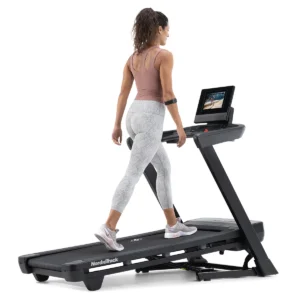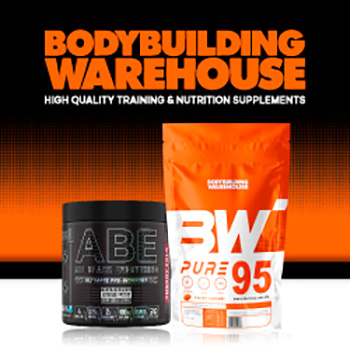
Studies have shown time and time again that running outdoors at a set speed will usually burn more calories than running at the same speed on a treadmill. This difference is mainly due to the wind resistance and changes in terrain that you face when running outdoors. A significant study in the Journal of Sports Sciences found that running outdoors required about 3-7% more energy when running at moderate to fast speeds compared to running on the best treadmills with incline at the same speed.
Running outside also burns more calories because you have to navigate uneven terrain, which activates more stabilizing muscles and requires continuous balance adjustments. The treadmill’s uniform surface and belt assistance reduce this additional workload, creating a more mechanically efficient running environment. While this efficiency might be beneficial for certain training purposes, it typically results in a lower overall caloric expenditure.
Offsetting the “Treadmill Advantage”
Researchers have found that by setting the incline on your treadmill to 1-2% during your indoor workouts, you can counterbalance the decreased energy expenditure of treadmill running. This small change effectively makes up for the lack of wind resistance and makes the energy cost more similar to running outdoors. For those runners who are trying to burn calories, this minor adjustment can significantly increase the efficiency of your workout without making you feel like you’re working much harder.
Another great way to burn more calories on the best treadmills with incline is through interval training. This type of training involves high intensity exercise followed by periods of rest. It not only increases the amount of energy you burn during your workout but also creates an afterburn effect, also known as excess post exercise oxygen consumption. This means you continue to burn calories even after your workout is over. And one of the great things about treadmills is that they allow you to control your workout precisely, making them perfect for structured interval training with specific work to rest ratios.
How Incline Settings Affect Calorie Burn
The ability to adjust the incline on treadmills is one of the best ways to make your workout harder and burn more calories. According to a study by the University of Georgia, running on a 5% incline burns about 30% more calories than running at the same speed on a flat surface. This makes working out on an incline a great way to get the most out of your workout when you don’t have a lot of time.
Incline training does more than just burn more calories, it also specifically targets posterior chain muscles like your glutes, hamstrings, and calves that are often underdeveloped in runners who primarily train on flat surfaces. This targeted strengthening leads to more balanced muscle development, which can reduce injury risk and improve running economy over time. For runners who don’t have access to natural hills, the best treadmills with incline training provides a valuable resource for developing hill specific strength and technique.
Boosting Stamina: Which Choice Yields More Effective Outcomes?
Treadmill and outdoor running both are successful in increasing cardiovascular stamina, but they each result in slightly different fitness changes due to their individual environmental factors. By understanding these differences, runners can decide the most suitable training environment for them based on their personal stamina objectives.
Heart and Lung Adjustments: Treadmill vs. Road Running
From a physical standpoint, your heart and lungs can’t tell the difference between running on a treadmill or outside they respond mainly to the intensity and length of the workout. Both settings can successfully increase VO2 max, cardiac output, and total aerobic capacity when the training stimulus is correctly applied. The main difference is not whether heart and lung adjustments happen but how consistently and accurately you can apply the perfect training stimulus.
Treadmills are great because they let you control your training variables like your heart rate zones, how fast you run, and how much you rest. This control lets runners hit their target training zones without any interruptions from the environment, which could lead to more predictable changes in their cardiovascular system. Outdoor running, on the other hand, puts your body through natural changes in pace, terrain, and conditions, which could lead to a more robust and adaptable cardiovascular system that can respond effectively to changing race conditions.
How Different Surfaces Affect Your Muscles
Running outside or on a treadmill each have their own unique biomechanics that can affect how your muscles develop. On a treadmill, the moving belt can assist with leg turnover, which means you don’t need to use your hamstrings as much to propel yourself forward. This can lead to a lack of strength in your posterior chain if you only run on a treadmill, which can potentially increase your risk of injury if you switch to running outside.
Running outdoors, particularly on uneven ground, naturally works a wider variety of muscles as your body constantly adapts to shifting surfaces. Studies using electromyography have demonstrated greater activation of ankle stabilizers and core muscles during outdoor running compared to running on a treadmill at the same speeds. These differences in muscle activation patterns suggest that a mix of both environments may provide the most complete muscular development for runners looking for balanced strength and endurance.
Getting Ready for the Race: The Importance of Surface Specificity
According to the principle of training specificity, your body is most effective at adapting to the exact conditions it will encounter during a performance. This means that for runners who are getting ready for outdoor races, some outdoor training is necessary as the day of the race gets closer. The proprioceptive skills, pacing awareness, and environmental adaptations that are developed through outdoor running can’t be fully replicated on a treadmill, no matter how advanced its programming is.
In other words, the best treadmills with incline are a great resource for training for specific races, especially when you need to simulate certain course features like long uphill stretches or timed intervals. A lot of top level coaches suggest a combination of both, using treadmills for very structured workout sessions and doing long runs and race pace runs outside to get the specific adaptations you need to do well on race day. This balanced approach uses the best of both worlds to get you as prepared as possible.
Comparing the Risk of Injury
When deciding whether to run on a treadmill or outside, one important factor to consider is the risk of injury. Both options have their own unique benefits and drawbacks. By understanding these differences, runners can make the best choice for their specific needs, taking into account their past injuries, biomechanical requirements, and current level of fitness.
How Running Surfaces Affect Impact Forces
Impact forces during running are significantly influenced by surface hardness. When running outdoors on surfaces like concrete and asphalt, each foot strike transmits about 2.5-3 times your body weight through your joints. In contrast, modern treadmills usually have cushioning systems that can reduce these impact forces by 15-40% compared to running on harder outdoor surfaces.
Treadmill running can be beneficial for runners with a history of stress fractures, joint issues, or those returning from injury because it reduces impact loading. The consistent, predictable surface also eliminates unexpected impacts from obstacles or surface changes that can trigger acute injuries outdoors. For runners requiring reduced impact, treadmills provide a reliable environment for maintaining training volume while managing injury risk.
Typical Injuries from Treadmills and How to Prevent Them
Even though they have a cushioned surface, treadmills can still cause injuries, usually due to changes in the way you run. The width of the belt is fixed, which can cause you to shorten your stride. This can put repetitive stress on certain parts of your body. Many people also tend to run more upright and lean forward less on treadmills. This can lead to less use of the hamstrings and more use of the quadriceps, which can cause certain types of injuries from overuse.
To lessen the chances of getting hurt on a treadmill, make sure to keep a good form. Don’t hold onto the handrails because it can cause you to have bad posture. Also, make sure you’re stepping wide enough and change up your position on the belt every once in a while instead of running in the exact same spot for a long time. The most important thing is to slowly transition between running on a treadmill and running outside. If you switch all your training from one to the other all at once, it can often cause injuries that are related to your body adapting to the new environment.
The Dangers of Weather for Outdoor Runners
Running outdoors can expose athletes to weather related injuries that can be completely avoided by training indoors. Extreme heat can increase core body temperature and cardiovascular strain, which can lead to heat exhaustion or heat stroke in severe cases. Cold weather can cause muscles to tighten and reduce blood flow to the extremities, while wet conditions can create a risk of slipping and can contribute to blisters and skin irritation. For more on the comparison between treadmill vs. outside running, you can explore additional resources.
Aside from immediate weather related dangers, factors such as shorter daylight hours can make runners train in the dark, which increases the risk of accidents due to lower visibility. For runners living in areas with severe seasonal changes, the best treadmills with incline training offers a safe alternative during the toughest weather times, allowing for consistent training without needless exposure to possibly hazardous conditions.
Combining the Two: Getting the Best of Both Worlds
Instead of seeing treadmill and outdoor running as either or options, the most effective training plans usually include both settings in a planned way. This combined approach lets runners take advantage of the special benefits of each choice while reducing their respective drawbacks, building a stronger and more flexible fitness foundation.
How to Train Smart Throughout the Year
One of the best ways to use both outdoor running and treadmill workouts is to adjust your routine based on the time of year. When it’s winter and the weather is cold, icy, and dark, you can do more treadmill workouts to stay safe and keep up with your training. But when the weather is nice in the spring and fall, it’s a great time to do more outdoor runs. You can work on running on different types of terrain and enjoy being out in nature.
Being able to run in any weather condition is not only safer, but it also provides a beneficial change to your training throughout the year. The body’s ability to adapt to different running environments creates a stronger fitness foundation than if you were to use only one environment. Many coaches intentionally plan “training blocks” that emphasize different environments based on the weather, creating a natural progression within the yearly training cycle.
Deciding Based on Weather
Aside from seasonal trends, your daily choices should also be influenced by the weather. If there are extreme conditions like thunderstorms, heat advisories, or air quality warnings, it’s obvious that treadmill training is the safer and better quality option. However, if the weather conditions are more moderate like light rain, mild heat, or moderate wind you might still want to run outdoors, especially if you’re training for a race where you might encounter similar conditions.
By creating a flexible decision making framework based on the conditions of the day, you can avoid the need for strict rules about when to run inside or outside. Instead, the choice of where to run each day becomes a strategic decision based on your specific workout goals, the current phase of your training, and the conditions of the day. This flexible approach ensures that the weather never becomes an excuse for missing a workout while still prioritizing safety and the quality of the workout.
Workout Schedules that Complement Each Other
Running workouts of different types are naturally suited to either treadmill or outdoor environments. High intensity interval training often benefits from the precise control of treadmill settings, which allows for exact work to rest ratios and consistent pacing throughout the session. On the other hand, recovery runs and easy days may be more enjoyable and mentally refreshing when conducted outdoors in natural settings, where the sensory stimulation can distract from physical fatigue.
A good training program will know how to use the best of both worlds. It might have you doing speed work and hill repeats on the treadmill, while saving your long runs and steady state efforts for the great outdoors. This way, you’re getting the most out of each type of workout, and you’re also mixing up your training stimuli throughout the week.
Which Workouts Are Best for Treadmills and Outdoor Running?
Some workouts are better suited to either the best treadmills with incline or outdoor running. Treadmills are great for progressive tempo runs where you need to control your pace, interval timing with quick recovery periods, and hill workouts with specific grade percentages. Outdoor running is better for simulating a race, downhill training (which most treadmills can’t do), and fartlek sessions where natural landmarks can be used for interval endpoints.
Price Point: What You Get for What You Pay
Many runners’ choices between treadmill and outdoor running are influenced by financial considerations. By recognizing the visible and hidden costs of both options, you can make smarter equipment investments and plan better for the future. For a detailed comparison, check out this treadmill vs outdoor running guide.
The Real Cost of a Quality Treadmill
High quality home treadmills are a big investment. Good, reliable models usually start at around £700, while top of the line models with all the bells and whistles can range from £1,500 to £3,000. This might seem like a lot to spend, especially for casual runners, but it’s important to think about this as a long term investment. A good treadmill should last you anywhere from 7 to 10 years with regular use, which means the cost is spread out over thousands of workouts. When you compare this to the cost of a gym membership over the same period, you might find that a treadmill is actually a better value.
Unseen Expenses of Running Outdoors
Outdoor running may seem like a cost free activity, but there are several expenses that can add up over time. Running shoes tend to wear out about 20% faster on rough outdoor surfaces compared to the smoother surface of a treadmill belt, which can increase how much you spend on shoes each year. If you run outside all year round, you will need different types of clothing for different weather conditions thermal layers for cold weather, waterproof jackets for rainy weather, UV protection for sunny weather, and cooling gear for hot weather which can add up to a significant investment in running clothes.
Additional costs for outdoor running may include travel expenses to get to safe or scenic running paths, fees to enter races, and possible medical bills for injuries related to weather or terrain. For city runners who prioritize safety, costs could also include reflective clothing, headlamps, and personal safety devices for running early in the morning or late at night.
Comparing Long Term Value
When it comes to long term value, consistency is key. Ultimately, the best exercise option is the one you’ll stick with, regardless of the cost difference. For runners who find it easier to stick to a treadmill workout during tough seasons or life events, investing in a home treadmill often pays off through better adherence and year round fitness.
How to Choose the Best Cardio Workout for You
When it comes to deciding between running on a treadmill or running outside, it’s not about saying one is better than the other. It’s about creating a plan that fits your individual needs, wants, and lifestyle. This tailored plan recognizes that different settings are better for different things and that most runners can benefit from a combination of both.
Think about your local weather, main fitness objectives, past injuries, time limitations, and what you enjoy when deciding on the best balance for you. Try out various mixes of indoor and outdoor exercise to see what works best for your specific circumstances. As your fitness level increases, the seasons change, and life happens, the most effective plan will probably change as well.
Commonly Asked Questions
We, as fitness professionals, get asked a lot about the differences between running on a treadmill and running outdoors. The answers below are the most common questions we get, with information based on facts to help you make better decisions about your training.
Is there a difference in calories burned when running on a treadmill versus running outdoors?
Yes, there is a difference. Running outside usually burns about 3-7% more calories than running on a treadmill at the same speed, mainly because of wind resistance and changes in terrain. However, by setting your best treadmills with incline to a 1% incline, you can effectively make up for this difference. Studies have found that this makes the energy expenditure the same as running outside at the same speed.
The difference in calories burned becomes more noticeable at faster speeds. Elite runners who run at speeds faster than 7 minutes per mile will notice a greater difference in calories burned between running outdoors and on a treadmill than beginners who run at speeds slower than 10 minutes per mile. This is because the impact of wind resistance is less significant at slower speeds.
The best way to compare the number of calories burned in different settings is to use a heart rate monitor instead of just trusting the calorie count on the treadmill. The treadmill’s calorie count often doesn’t take into account personal factors like how fit you are, what your body is like, and how well you run.
If you’re trying to lose weight, the key is consistency, not the slight difference in calories burned. Pick the place where you’re most likely to stick to your workout schedule. You’ll get better results from regular workouts in either place than you would from occasional workouts in the “best” place.
What can I do to make treadmill running less monotonous?
There are several ways to make treadmill running less monotonous. Try varying your workouts by changing the pace or incline, or by using intervals. This can help to keep your mind engaged and make the time pass more quickly. Another option is to listen to music, podcasts, or audiobooks, or to watch TV shows or movies. Some people find that saving certain shows or books for when they are on the treadmill helps them to look forward to their workouts.
Is it better for beginners to run on a treadmill or outside?
For beginners, treadmills often provide a more controlled environment that is less intimidating. The predictable surface of a treadmill minimizes the risk of injury from falls or twisted ankles. The ability to precisely control the speed on a treadmill can help prevent beginners from starting too fast and burning out quickly, which is a common mistake. The stop button on a treadmill provides immediate relief if needed, which can help build confidence as fitness gradually improves.
From a practical point of view, treadmills help beginners concentrate on improving their running form without having to worry about changes in terrain, traffic, or finding their way. This single minded focus often speeds up the initial learning process. The accurate feedback from the treadmill display also helps beginners learn how to perceive pace a vital skill that usually takes time to develop when running outdoors.
However, relying solely on treadmill training might hinder the growth of essential outdoor skills such as managing your pace and adapting to different terrains. Ideally, beginners should start with mostly treadmill workouts to develop their skills in a controlled environment, then slowly add outdoor runs as they gain confidence and fitness.
- Beginners with joint concerns or significantly excess weight may benefit from starting exclusively on treadmills to reduce impact forces
- Those training for outdoor events should transition to include at least some outdoor running within the first 2-3 months of training
- Alternating environments helps prevent overuse injuries by varying the specific stresses placed on muscles and joints
- Beginners often benefit from starting with treadmill “walk, run” programs before transitioning to continuous running
Can I train for an outdoor race exclusively on a treadmill?
While it’s technically possible to prepare for an outdoor race using only the best treadmills with incline training, this approach creates a significant disadvantage on race day. The principle of specificity in exercise physiology states that your body adapts specifically to the conditions it regularly encounters during training. Without outdoor running experience, you’ll lack crucial adaptations to elements like wind resistance, varied terrain, weather conditions, and the proprioceptive demands of uneven surfaces all factors that significantly impact race performance.
What treadmill settings should I use to mimic outdoor running?
Many studies suggest that setting your treadmill to a 1% incline accurately represents the energy cost of outdoor running without wind resistance. This incline is a small adjustment that makes your indoor running experience similar to running outdoors on a flat surface, as shown by studies comparing oxygen use in both settings.
Keep in mind that treadmills aren’t all calibrated the same way, and the belt can start to slip as time goes on, which can throw off the pace shown on the display. If you want to train as accurately as possible, every now and then you should check how accurate your treadmill is by using a foot pod or GPS watch on a measured outdoor course. Then you can adjust the paces on your treadmill to make sure your training stays consistent. For more insights on treadmill usage, you can read about treadmill vs outdoor running and make an informed decision.
In the end, the question of treadmill versus outdoor running isn’t about identifying a single “superior” method but about learning how to tactically include both settings into a full workout program. By using the specific benefits of each method and reducing their drawbacks, you can develop a stronger, more flexible, and lasting running routine that backs your long term fitness objectives. For more insights, consider reading about the comparison between treadmill and outdoor running.
Runners looking for top notch home treadmill options that successfully combine the convenience of indoor workouts with the quality of outdoor training will find that Fitness Option provides innovative solutions. Our gear is designed by runners, for runners. It merges the exact control provided by treadmill technology with features that are biomechanically optimized, resulting in a more realistic running experience.






